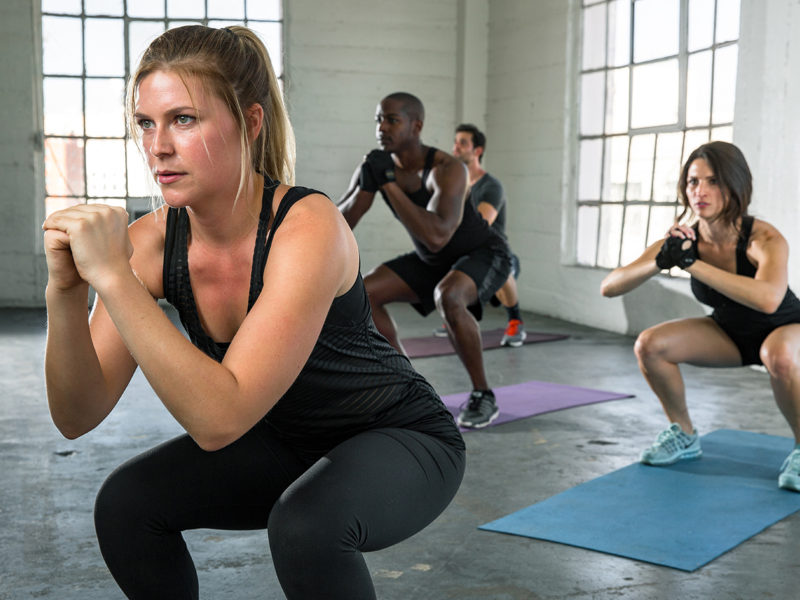12 Steps to Reach Your Goals
By Travis Fishburn
Last updated: Aug 08, 2014
When it comes to fitness, it’s easy to steer off course. Beginners often go hard for a few weeks, or even a few months, but many stall after their short-term motivation goes out like a candle. If you’re determined to make fitness a long-term facet of your lifestyle, you can get back on course, smash PRs, and meet strength and physique goals with these 12 simple tips.
-
Set Goals
Goals are essential to long-term progress. Unless you want to waste your time flailing around at the gym, you need to set specific and measurable goals. Define your goals. Then determine smaller more attainable goals to be achieved incrementally that will lead to accomplishing your ultimate goal. For example, you wish to lose 30lbs this year. Instead of focusing on losing 30lbs, first focus on losing 1-2lb per week, then 4-8lb per month. Succeeding in these smaller goals provides motivation and encouragement toward the original larger goal.
-
Write Your Goals Down
Taking pen to paper might seem a bit generic, but having concrete evidence of your goals from the start can limit the likelihood that you’ll stray from them when times get tough. If you have a strength goal, you can chart your weekly progress toward a new personal record. If you have a physique goal, take progress pictures so you can measure weekly improvements. With consistent tracking, you’ll know where you’re going and where you’ve been.
-
Educate Yourself
Learn something new about training every day. Seek out credible sources
-
Nail Your Nutrition
How important is sound nutrition for optimal quality of life?….extremely important. Everything you put into your body affects you on a cellular level, so choose wisely. Think of your body as if it were a car. If you don’t use quality fuel, regular oil changes and maintenance, your car will wear out much sooner.
One of the most important lessons I’ve learned during my training is proper food prep. It’s the bedrock of any training program. I know from personal experience that failure to plan ahead is a surefire way to steer off course, so dedicate one or two days each week to meal prep and make your nutrition as much of a priority as training.
I usually do all my grocery shopping on Sunday morning, then spend a few hours cooking in bulk and dividing meals into Tupperware. As a result, my week starts relatively stress-free. If I know I’ll be out of town for a while, I’ll take several meals and snacks with me in my insulated 6 Pack Fitness bag.
Everyone knows that poor dietary choices can lead to a host of health problems including diabetes, obesity, and hypertension. Still, even if it’s not at an extreme, poor diet can affect you in other ways that will impact your training: poor sleep, increased inflammation of the tissue, and slower recovery time.
My advice: Keep things simple, eat whole foods, and “eat the rainbow.” Get as much color on your plate as possible. Choose healthful foods from each of the following food groups for a well rounded diet providing adequate vitamins, minerals and nutrients.

Foods I recommend as part of a well-balanced healthy meal plan:
- Lean Proteins
- Fish, chicken/turkey breast, lean pork and beef (moderation), legumes/beans, soy (ex. tofu, soymilk, tempeh), eggs (moderation) and egg whites
- Grains
- Whole grains (ex. brown rice, oatmeal, quinoa, 100% whole grain breads and pastas)
- Starchy Vegetables
- Potatoes, acorn squash, corn, peas, legumes
- Vegetables
- Broccoli, spinach, asparagus, peppers, tomatoes, carrots, celery, cucumber
- Fats
- Olive oil, flaxseed, avocado, nuts, fatty fish, almond butter
- Fruit
- Apples, Oranges, Berries, Grapefruit, Pineapple, Plums, Kiwi
- *focus on whole fruit and minimize fruit juice and dried fruit
- Things to avoid or minimize
- Trans-fat, saturated fat, high-fructose corn syrup/refined sugars, highly processed foods, baked goods, fast food, salt/high sodium seasonings/condiments, alcohol
-
Find A Training Partner
Seek out the experts. Someone always knows more than you and, more often than not, they’re willing to share their knowledge. A study from Kansas State University found that people who exercise with someone who they perceive as being athletically superior push harder—the cyclists observed rode 90 percent longer!
-
Address Your Weakness
Just like stretching and hydrating, trying to improve on your weaknesses should be emphasized. Many people concentrate on continuing to train their upper body while neglecting their lower half.
-
Build Mental Toughness
The thing that separates one trainee from another might not be their physical strength. The difference often comes down to mental toughness and the decision to power through. You’re capable of so much more than what your sub-conscious mind tells you. Just remember this: There are plenty of people in this world who will root against you. Don’t let yourself become one of them.
-
Keep A Fitness Log
A log is great for several reasons. First, it’s a good record of how far you’ve come and a great way to get into specifics since you can log your weights, reps, and sets. Recording your workout sessions also keeps you focused on the task at hand. After all, you’re less likely to get distracted when you have a firm goal in mind. Fitness logs help you learn more about your body, your training, your nutrition, and what does and doesn’t work for you.
-
Hydrate, Hydrate, Hydrate
Aim for no less than 64oz of water each day. Some authorities recommend up to 1/2 your lean body weight in ounces of water daily. Remember to replace any fluids lost through exercise or activity. Weigh yourself before exercise and after exercise. Replace each pound lost with 16oz of water.
-
Allow For Ample Rest And Recovery
Muscle fibers break down during exercise and rebuild into their bigger, stronger counterparts during rest and recovery. Schedule rest days to avoid overtraining and injury. For strength training – allow muscles to fully recover with no muscle soreness before training that muscle group again.
-
Prioritize Flexibility
Flexibility should be a part of your exercise routine. Always remember the best time to stretch is after your workout when muscles are warmed up. Minimum recommendation is 2-3 days per week of static stretching for every major muscle group.
-
Remember, Never Quit
Your mind is the most powerful weapon you have. When your body wants to quit, you have to rely on your mind to push you harder. Sometimes it takes a while to reach certain goals. Some days, you just don’t have motivation. In those times, you have to pull from something even deeper: belief. Stay focused and dedicated.




